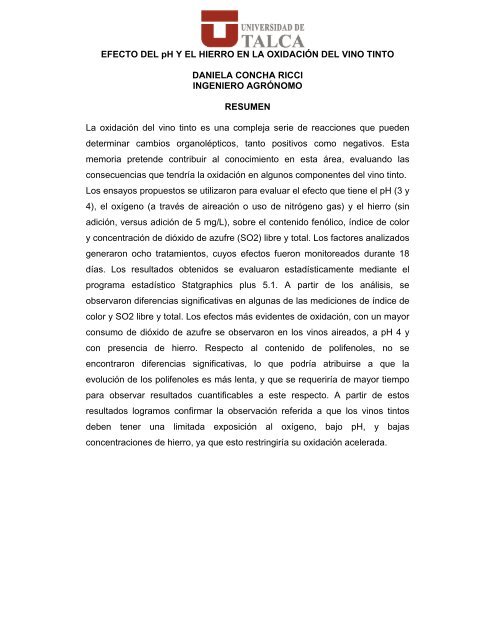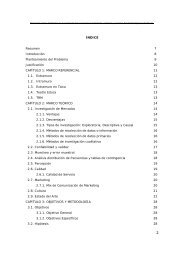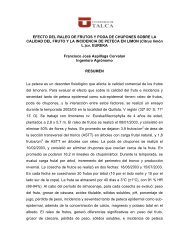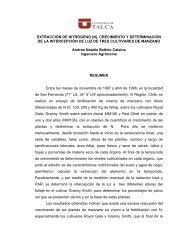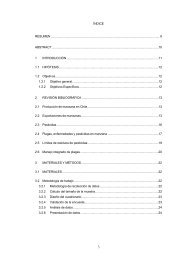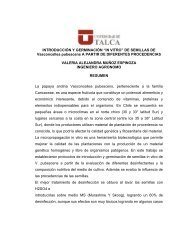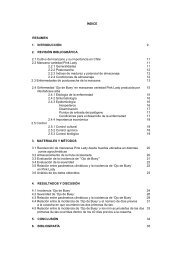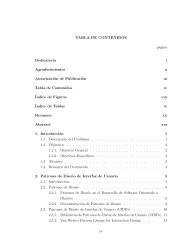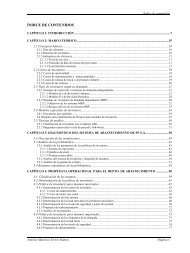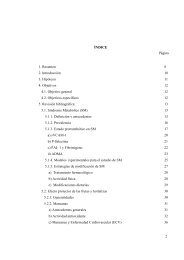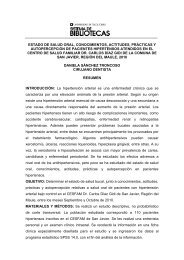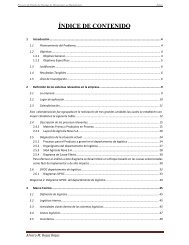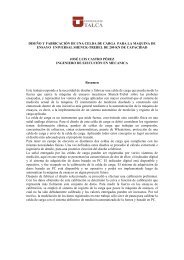EFECTO DEL pH Y EL HIERRO EN LA OXIDACIÓN DEL VINO ...
EFECTO DEL pH Y EL HIERRO EN LA OXIDACIÓN DEL VINO ...
EFECTO DEL pH Y EL HIERRO EN LA OXIDACIÓN DEL VINO ...
Create successful ePaper yourself
Turn your PDF publications into a flip-book with our unique Google optimized e-Paper software.
<strong>EFECTO</strong> <strong>D<strong>EL</strong></strong> <strong>pH</strong> Y <strong>EL</strong> <strong>HIERRO</strong> <strong>EN</strong> <strong>LA</strong> <strong>OXIDACIÓN</strong> <strong>D<strong>EL</strong></strong> <strong>VINO</strong> TINTO<br />
DANI<strong>EL</strong>A CONCHA RICCI<br />
ING<strong>EN</strong>IERO AGRÓNOMO<br />
RESUM<strong>EN</strong><br />
La oxidación del vino tinto es una compleja serie de reacciones que pueden<br />
determinar cambios organolépticos, tanto positivos como negativos. Esta<br />
memoria pretende contribuir al conocimiento en esta área, evaluando las<br />
consecuencias que tendría la oxidación en algunos componentes del vino tinto.<br />
Los ensayos propuestos se utilizaron para evaluar el efecto que tiene el <strong>pH</strong> (3 y<br />
4), el oxígeno (a través de aireación o uso de nitrógeno gas) y el hierro (sin<br />
adición, versus adición de 5 mg/L), sobre el contenido fenólico, índice de color<br />
y concentración de dióxido de azufre (SO2) libre y total. Los factores analizados<br />
generaron ocho tratamientos, cuyos efectos fueron monitoreados durante 18<br />
días. Los resultados obtenidos se evaluaron estadísticamente mediante el<br />
programa estadístico Statgraphics plus 5.1. A partir de los análisis, se<br />
observaron diferencias significativas en algunas de las mediciones de índice de<br />
color y SO2 libre y total. Los efectos más evidentes de oxidación, con un mayor<br />
consumo de dióxido de azufre se observaron en los vinos aireados, a <strong>pH</strong> 4 y<br />
con presencia de hierro. Respecto al contenido de polifenoles, no se<br />
encontraron diferencias significativas, lo que podría atribuirse a que la<br />
evolución de los polifenoles es más lenta, y que se requeriría de mayor tiempo<br />
para observar resultados cuantificables a este respecto. A partir de estos<br />
resultados logramos confirmar la observación referida a que los vinos tintos<br />
deben tener una limitada exposición al oxígeno, bajo <strong>pH</strong>, y bajas<br />
concentraciones de hierro, ya que esto restringiría su oxidación acelerada.
ABSTRACT<br />
Red wine oxidation is a complex series of reactions that can determine both<br />
positive and negative sensory changes. This report aims to contribute to the<br />
knowledge in this area, evaluating the consequences of oxidation in some of the<br />
components of red wine. The proposed tests were used to evaluate the effect of<br />
<strong>pH</strong> (3 and 4), oxygen (through the use of aeration or nitrogen gas) and iron<br />
(without adition, versus the addition of 5 mg/L) on the phenolic content, color<br />
index, and free an total sulfur dioxide (SO2) concentration. The variables<br />
studied produced eight treatments, whose effects were monitored during 18<br />
days. The results obtained were statistically evaluated using the software<br />
package Statgraphics plus 5.1. From the analysis, significant differences were<br />
observed in some of the measurements of color index, free and total SO2. The<br />
most obvious effects of oxidation, observed as increased consumption of sulfur<br />
dioxide, was obtained in aerated wines, at <strong>pH</strong> 4 and in the presence of iron.<br />
Regarding the content of polyphenols, there were no significant differences,<br />
which could be attributed to the slower evolution of this compounds, requiring<br />
more time to see measurable results. From these results, we confirm that red<br />
wines should have a limited exposure to oxygen, low <strong>pH</strong>, and low<br />
concentrations of iron, in order to restrict a rapid oxidation.


